Wander.al uses cookies to improve user experience. By using our website you consent to all cookies in accordance with our Cookie Policy.
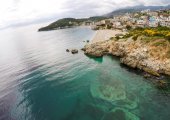
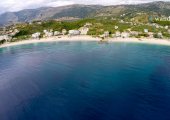
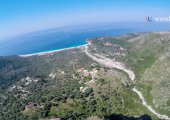
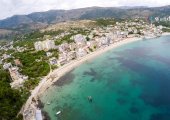
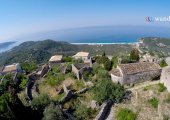
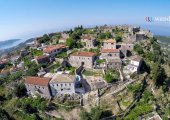
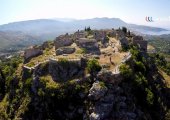
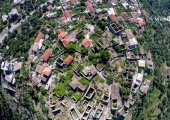










The town of Himarë consists of the old town, Kastro, situated on and around the old castle and the coastal region of Spilea, which is the touristic and economic center of the region. Other parts of the town are Potami, Livadhi, Zhamari, Michaili and Stefaneli. North of the town of Himarë lie the villages of Vuno, Ilias, Dhërmi and Palasë. Dhermi contains a number of recently built beach resorts. On the mountains lie Pilur and Kudhës, while Qeparo lies to the south of the town of Himarë.
The region has several Orthodox churches and monasteries, built in the traditional Byzantine architecture, like the Monastery of the Cross, Athaliotissa, Saint Theodore, Virgin Mary in Dhërmi and Saint Demetrius. Moreover, a number of churches are located inside the castle of Himarë, which was initially built in classical antiquity, like the Church of Virgin Mary Kasopitra, Episkopi, which is built on the site of an ancient temple dedicated to Apollo, as well as the Aghioi Pantes church, in the entrance of the castle. Additional monuments in the castle include the mansion of the Spyromilios family and the Greek school.
In classical antiquity, Himarë was part of the Kingdom Epirus under the rule of the Molossian Aeacid dynasty, which included King Pyrrhus of Epirus. When the region was conquered by the Roman Republic in the 2nd century BC, its settlements were badly damaged and some were destroyed by the Roman General Aemilius Paulus.
Himarë and the rest of the southern Balkans passed into the hands of the Byzantine Empire following the fall of Rome, but like the rest of the region it became the frequent target of various attackers including the Goths, Avars, Slavs, Bulgars, Saracens and Normans. Himarë is mentioned in Procopius of Caesarea's work of 544 called Buildings, as Chimaeriae. He mentions it of being part of Old Epirus and that a new fortress was built in its location.
The use of the name "Chaonia" in reference to the region apparently died out during the 12th century, the last time it is recorded (in a Byzantine tax collection document). In 1278, Nicephorus of Epirus surrendered to the Angevins the ports of Himarë, Sopot and Butrint. As a result, Charles of Anjou controlled the Ionian coast from Himarë to Butrint. It was later ruled by Serbian Empire between 1342 and 1372. In 1372 Himarë, together with Vlora, Kanina and Berat region was given as a dowry to Balša II due to his marriage with the daughter of John Komnenos Asen. After the death of Balša II, his widow and his daughter (who married Mrkša Žarković) managed to keep the possession of the region up to 1417 when the Ottomans captured Vlora.
The Ottoman Empire overran northern Epirus from the late 14th century, but being a natural fortress, Himara was the only region that did not submit to Ottoman rule. It became a symbol of resistance to the Ottoman but suffered from an almost continuous state of warfare. In the summer of 1473 the chieftain John Vlasis, with a small unit from nearby Corfu as well as with native Himariot support, took control of the entire coastal region from Sagiada to Himara, but when the ongoing Ottoman-Venetian war ended (1479) the region was again under Ottoman control. In 1481, one year after the Ottomans had landed in Otranto in southern Italy, the Himariotes joined the forces of Gjon Kastrioti II (son of Skanderbeg) in his uprising against the Ottomans. The uprising failed, but the Himariotes rose up again in 1488, and between 1494–1509, destabilizing Ottoman control but failing to liberate their territory.
The Ottoman Sultan Suleiman the Magnificent personally mounted an expedition in 1537 that destroyed or captured many surrounding villages but did not manage to subdue the area. The Ottomans found it necessary to compromise with the inhabitants by giving them a series of privileges: local self-government, the right to bear arms, exemption from taxes, the right to sail under their own flag into any Ottoman port and to provide military service in time of war.
In 1797, Ali Pasha, the Muslim Albanian ruler of the Ottoman Pashalik of Yanina, led a raid on the town of Himarë because they supported his enemy, the Souliotes, and more than 6,000 civilians were slaughtered. Two years later, Ali Pasha tried to create good relations with the Himariotes after declaring their enclave part of his emerging semi-independent state, by financing various public works and churches. A church he built near Himarë, opposite of the Porto Palermo Castle is the largest and most magnificent in the region and still stands today as a major tourist attraction. Ali Pasha's rule over Himarë lasted about 20 years until it was abruptly terminated by his murder at the hands of the Ottoman agents. Himarë subsequently reverted to its status quo ante of an enclave surrounded by Ottoman territory. To emphasize the region's special status, the terms that the Himariotes had reached with Suleiman the Magnificent were inscribed on bronze tablets at the request of their leaders, who wanted to record the agreement on a durable medium. These tablets are preserved to this day in the Topkapi palace museum in Istanbul.
Today, the inhabitants of Himara are Orthodox Christians. In 1577, 38 chieftains of the Himara region appealed to Pope Gregory XIII for arms and supplies against the Ottomans. They promised to switch allegiance from the Orthodox to the Roman Catholic Church, and recognize Philip II of Spain as their sovereign. From 1577 to 1765 the population accepted the Pope as the religious head of the community and identified with the Roman Catholic Church. The success of the Roman Catholic missionaries among the Eastern-rite Albanians in Himarë led to the region becoming a refuge for Orthodox prelates that had converted. Himariotes thus largely adhered to Christian faith, although individual conversions to Islam were recorded from early 16th century.